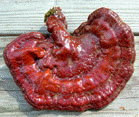|
|
Mushroom-Collecting.com A New England and Eastern Canada Edible and Medicinal Mushroom Resource |
|
Home
Chanterelle (Cantharellus cibarius) Black Trumpet (Craterellus cornucopioides, C. cenerius, C. foetidus) Small Chanterelles (Craterellus tubaeformis, C. ignicolor) Hedgehog (Hydnum repandum, H. umbilicatum) Horse and Meadow Mushroom (Agaricus arvensis, A campestris) Parasol Mushroom (Macrolepiota procera) Shaggy Mane (Coprinus comatus) (White) Matsutake (Tricholoma magnivelare) Blewit (Lepista nuda) Oyster Mushroom (Pleurotus ostreatus, P. populinus)
King Bolete (Boletus edulis) Boletus variipes and other. Two Colored Bolete (Boletus bicolor) Maitake (Grifola frondosa) Chicken of the Woods (Laetiporus sulphureus) Dryads Saddle (Polyporus squamosus)
Morels (Morchella esculenta, M. elata) Puffballs (Calvatia gigantea, Calvatia cyathiformis, others) Lobster Mushroom (Hypomyces lactifluorum) Aborted Entoloma (Entoloma abortivum)
Medicinal Mushrooms Maitake (Grifola frondosa) Reishi (Ganoderma tsugae, G. lucidum) Turkey Tail (Trametes versicolor) Chaga (Inonotus obliquus) Artist's Conk (Ganoderma applanatum)
Collecting, Photographing and
Cooking Collecting
Tips Evaluating
Flavor Dyeing Fabrics and Paper with Mushrooms
|
Rules for Collecting Mushrooms Be
sure to buy a good field guide such as National
Audubon Society Field Guide to North American Mushrooms (National
Audubon Society Field Guide Series). Get more than one book.
1.
Make a positive identification using more than one source
wherever possible. Do not eat mushrooms with any features that
contradict the description.
Contact a mushroom expert or club if you are not sure.
"When in doubt, throw it out!" 2.
Only pick specimens with opened caps. Mushrooms can easily be
misidentified in the button stage. 3.
Keep your known edibles separate from unknown species. Any
unknown mushroom is possibly dangerous. 4.
Take notes on all important aspects of the environment including
types of trees, plants, other fungi, soil, forest or land
characteristics, and any other unusual aspects of the location. Itís
best to write it down and keep your notes with your finds. 5.
Use every aspect of the physical structure for identification
including a spore print. Spore prints should be made on black or white
paper or glass. 6.
Be able to distinguish a mushroom species from its close
relatives and unrelated look-a-likes. 7.
Learn what the deadly species look like and the symptoms of
poisoning. 8.
Avoid picking "little brown mushrooms" and difficult to
identify or poisonous species like amanita, galerina, entoloma, and
cortinarius. Beginners should also avoid lepiota, lactarius and russula
species. Learn the basics of these genera so you can walk by them. 9.
Never eat any bulbous based gilled mushroom growing from a sac or
cup. Those are likely to be amanitas, many species of which, are deadly. 10.
Avoid boletes with red or orange pores that stain blue. Blue
staining mushrooms should always raise a caution flag although a few can
be eaten. For
beginners black staining mushrooms are best avoided too. 11.
For beginners itís safer to start by collecting mushrooms with
pores, teeth and ridges rather than gilled mushrooms. 12.
Avoid polluted, treated, or sprayed areas. Weed-less lawns should
be avoided. Fruit tree orchards should be avoided unless you know for
sure they havenít been sprayed. Pesticide residues can remain in the
soil for many years. Possibly decades. Lead arsenate stays in the soil
even longer than the DDT that succeeded it. 13.
Donít pick next to busy, paved roadways. There could still be
lead in the soil from leaded gasoline we used to burn and cadmium from
tire rubber dust. On busy roadways pollution spreads from cars in a way
similar to the dust cloud behind a cattle stampede. 14.
Realize that there are no simple rules of thumb about edibility
such as ďif it stains a silver spoon....Ē or other
generalizations. 15.
Do not damage the environment. Avoid picking or knocking over
mushrooms you donít intend to keep. Fill any holes in the dirt or duff
so the underlying mycelium does not dry out or become damaged. Itís
best not to use a rake for finding matsutake. A good mushroom hunter
leaves few traces behind. 16.
Always cook your mushrooms thoroughly. There are bacteria in the
outdoors and you could become ill from something entirely unrelated to
the mushroom. 17.
Only consume fresh specimens. Older specimens may be spoiling. 18.
Chew them well and donít overdo it. 19.
Try one new species at a time eating only a small amount at first
retaining a sample of the new species in case of poisoning or allergic
reaction. Just as some people canít eat, nuts, strawberries, shellfish
or other foods, allergic responses to some mushrooms are certainly
possible. 20.
When fall rolls around and the hunting seasons begin, wear hunter
orange in the woods at all times! As with all rules and descriptions there are always exceptions. Size of mushrooms in particular can be quite variable. I have been puzzled on quite a number of occasions by mushrooms that were much larger than descriptions indicate. Every once in a while you will find 12 inch or larger boletes, horse mushrooms, oysters or others. I have learned that a 10 inch platterful or blewit is definitely possible. 2006 was a wet year and chanterelles commonly had 4-6 inch caps. It can throw you so realize that size can be much greater than field guide parameters suggest. The chart below is from Wikipedia |

